A Mathematical Model of Competition between Cassava and Yam
DOI:
https://doi.org/10.63561/jmns.v2i3.868Keywords:
Cassava, Yam, Biodiversity, Stability, ODE45, Simulation, Biomass, Mathematical modelAbstract
In this paper, we propose a mathematical model for the interaction between Cassava (Manihot esculenta) and Yam (Dioscorea spp.) biomass using a system of non-linear ordinary differential equations (ODEs). The mathematical analysis of the uniqueness, local and global stability of the model was investigated. Additionally, a computationally efficient numerical method for solving ordinary differential equations of order 45 (ODE45) was used to simulate the biomass of Cassava and Yam, considering variations in the growth rate parameters. It was discovered that decreasing the growth rates of Cassava from 10 percent to 99 percent results in biodiversity loss. In contrast, when the growth rates were increased from 101 percent to 120 percent, the results changed from biodiversity loss to biodiversity gain.
References
Abanum, G., Omoregbe, C., & Ekakaa, N. (2020). Numerical simulation of biodiversity loss: comparison of numerical methods. International Journal of Mathematics Trends and Technology, 66(3), 53-64. DOI: https://doi.org/10.14445/22315373/IJMTT-V66I3P508
Abanum, G., & Eli, I. (2022). Computational and mathematical modeling of industrial assets: Alternative numerical approach. Asian journal of pure and applied mathematics, 4(2), 45-59.
Abanum, G., Eli, I., & Iweobodo, D. (2024). Computational Modelling of Agricultural Assets. Universal Journal of Applied Mathematics, 12(1), 1-17. DOI: 10.13189/ujam.2024.120101. DOI: https://doi.org/10.13189/ujam.2024.120101
Abanum, G., & Oke, K. (2019). Modified variation iteration method for the solution of seventh order boundary value problem using canonical polynomial. International journal of modern mathematical science, 17(1), 57-67
Agyemang, I., & Freedman, I. (2009). An Environmental Model for the Interactions of Industry with two Competing Agricultural Resources. Mathematical and Computer Modelling, ELSEVIER, 49, 1618-1643. DOI: https://doi.org/10.1016/j.mcm.2008.06.001
Agyemang, I., Freedman, I., & Macki, J. (2007). An ecospheric recovery model for agriculture industry interactions. Diff. Eqns. Dyn. Syst, 15, 185-208.
Antle, J., & Valdivia, R. (2006). Modelling the Supply of Ecosystem Services from Agriculture: A Minimum Data Approach. The Australian journal of agricultural and resource economics, 50, 1-15. DOI: https://doi.org/10.1111/j.1467-8489.2006.00315.x
Donatelli, M., Mgarey, D., Bregagtio, S., Willecquet, L., Wish, J., & Savary, S. (2017). Modelling the Impacts of Pests and Diseases on Agricultural Systems. Agricultural System, Elsevier 155, 213-224. DOI: https://doi.org/10.1016/j.agsy.2017.01.019
Eli, I., & Abanum, G. (2020). Comparison between analytical and numerical result of stability analysis of a dynamical system. Communication in physical sciences, 5(4), 473-440
Eleki, G., & Ekaka, E. (2019). Computational Modelling of Ecospheric assets: alternative Numerical Approach. African Scholar Journal of Sustainable Development, 15(2), 105-115.
Eleki, G., & Ekakeaa, E. (2019). Differential Effects of a Scenario of the non-additive environmental perturbation on biodiversity of the Ecospheric Assets: Kalabari Kingdom Ecosystem. African Scholar Publications and Research Internationally, 1-15.
Imoni, S., Edogbayan, H., Badaki, J., Oyem, A., & Koffa, J. (2019). Existence and Uniqueness Analysis of Transmission Model of Schistosomiasis. FUW Trends in Science and Technology Journal, 4(2), 530-533.
Iweobodo, D., Abanum, G., Ochonogor, N., Apanapudor, J., & Njoseh, I. (2024). A Galerkin Finite Element Technique With Iweobodo-Mamadu-Njoseh Wavelet (IMNW) Basis Function For The Solution of Fractional Advection-Diffusion Problems. Partial Differential Equations in Applied Mathematics, 12. https://doi.org/10.1016/j.padiff.2024.100965. DOI: https://doi.org/10.1016/j.padiff.2024.100965
Lanlege I., & Imoni, S. (2018). Using Mathematical Modelling of Understanding the Cause and theWay to Prevent Outbreak Diseases (Zika Virus), Abacus, Mathematical Science Series, 46(1), 239-257.
Liu, P. (2010). An Analysis of a Predator-Prey Model with Diffusion and Migration. Mathematical and Computer Modelling, Elsevier, 51, 11064-1070. DOI: https://doi.org/10.1016/j.mcm.2009.12.010
Li, Z., Liang, Z., & Yan, Y. (2017) High-order Numerical Methods for Solving Time Fractional Partial Differential Equations. Scientific Computing, 71(2), 785-803. DOI: https://doi.org/10.1007/s10915-016-0319-1
Mittelbach, G. (2012). Community Ecology. Sinauer Associates, Sunderland, Massachusetts.
Morin, P. J. (2002). Community Ecology.Blackwell Science, Inc.
Quinn, J., Brandle, J., & Johnson, J. (2013). A farm-scale biodiversity and ecosystem services assessment tools: The healthy farm index. International journal of sustainability, 11(2), 176-192. DOI: https://doi.org/10.1080/14735903.2012.726854
Vandermeer, J., & Goldberg, D. (2013). Population Ecology: First Principles. 2nd edition, Princeton University Press, Princeton. DOI: https://doi.org/10.1515/9781400848737
Wang, Z. H. (2008). Numerical stability test of neutral delay differential equations. Mathematical problems in Engineering, 3(4), 1-10. Dio:10.1155/2008/698043. DOI: https://doi.org/10.1155/2008/698043


